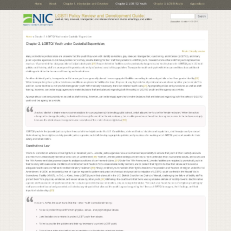
National Institute of Corrections
Keywords: Best Practices; Juvenile Justice; Policy; PREA; Secure Facilities
Many corrections professionals are unaware that the youth they work with identify as lesbian, gay, bisexual, transgender, questioning, and intersex (LGBTQI), and many juvenile justice agencies do not have policies nor do they provide training for their staff that pertains to LGBTQI youth. Research shows that LGBTQI youth represent as much as 15 percent of the total population of adjudicated youth. Secure detention facilities can be particularly dangerous and hostile places for LGBTQI youth. Without policies and training, staff are unprepared to provide safe and professional care to this population. Transgender youth and youth with intersex conditions face additional challenges in detention because of housing and medical care.
As other detained youth, transgender and intersex youth are generally placed in sex-segregated facilities according to external genitalia rather than gender identity. When transgender girls or girls with intersex conditions are placed in facilities for boys, they are at very high risk for physical and sexual abuse by other youth and staff. In addition, some facilities do not provide transgender youth with medically necessary, transition-related health care. Appropriate policies and procedures as well as staff training, however, can better equip agencies to make decisions that are balanced regarding both the safety of LGBTQI youth and the agency as a whole.
Appropriate policies and procedures as well as staff training, however, can better equip agencies to make decisions that are balanced regarding both the safety of LGBTQI youth and the agency as a whole. [Summary from resource.]
File : pdf with 0.19 MB in size
LGBTQI Youth under Custodial Supervision. LGBTI Policy Review and Development Guide microsite.